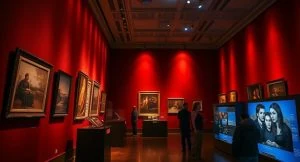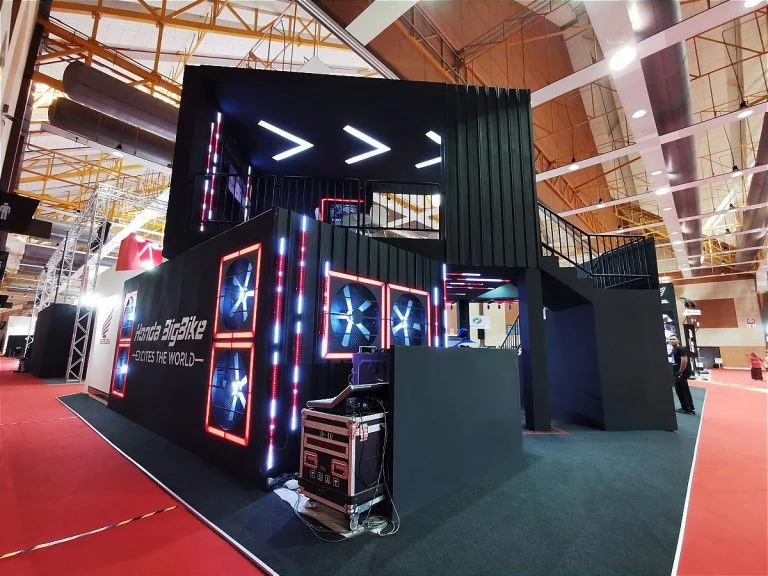Inspiring Innovations: The Art of Exhibition Design & Fabrication
Step into a world of creativity and imagination with the art of exhibition design and fabrication. From captivating visuals to interactive displays, exhibitions have the power to transport us to new realms and leave a lasting impact.
In this article, we will delve into the inspiring innovations that drive the world of exhibition design and fabrication. Whether it’s a museum showcasing ancient artifacts or a trade show highlighting cutting-edge technology, the meticulous planning and attention to detail behind these immersive experiences are truly remarkable.
From concept to execution, exhibition design and fabrication require a multidisciplinary approach that combines elements of art, architecture, and storytelling. It’s not just about creating a visually appealing space; it’s about crafting an unforgettable journey for visitors, one that informs, educates, and sparks curiosity.
By exploring the latest trends, technologies, and strategies used in exhibition design and fabrication, we will uncover the secrets to creating impactful and memorable experiences. So, fasten your seatbelts and get ready to be inspired by the world of exhibition design and fabrication.
The importance of effective exhibition design
Effective exhibition design plays a crucial role in creating memorable experiences that resonate with audiences. It serves as the bridge between the message and the audience, transforming ideas into engaging visual narratives. When done right, exhibition design can captivate visitors, drawing them into a world of creativity and information. This immersive experience not only enhances the aesthetic appeal of the space but also facilitates deeper understanding and connection to the subject matter. With the right design, exhibitions can leave a lasting impression, inspiring curiosity and fostering a love for learning.
Moreover, effective design is essential for communicating the core message of the exhibition. It provides a framework for storytelling, allowing designers to weave narratives that guide visitors through the space. This storytelling element not only informs but also evokes emotions, making the experience more relatable and impactful. The layout, flow, and visual elements all contribute to how the audience interacts with the content. A well-designed exhibition can spark important conversations and reflections, encouraging visitors to engage with the subject matter on a more profound level.
In an age where attention spans are dwindling, the importance of effective exhibition design cannot be overstated. As competition for visitor engagement intensifies, exhibitions need to stand out and offer unique experiences. By integrating innovative design principles and technologies, designers can create environments that are not just visually appealing but also intellectually stimulating. This holistic approach to exhibition design ensures that visitors leave with not just memories but newfound knowledge and inspiration that can influence their thoughts and actions long after they depart.
Partner with Moonman Events to transform your message into a captivating exhibition, blending innovative design and seamless execution. Explore our services at Moonman Events and start creating unforgettable experiences today.
Key elements of successful exhibition design
Successful exhibition design hinges on several key elements that work in harmony to create an engaging experience. One of the most critical aspects is spatial organization. The arrangement of exhibits and the flow of movement within the space significantly influence how visitors interact with the content. Designers must carefully consider the layout to facilitate an intuitive journey that encourages exploration and discovery. A well-planned spatial design minimizes congestion and ensures that each exhibit is given the attention it deserves, allowing visitors to fully absorb the information presented.
Another essential element is the visual hierarchy, which guides the audience’s focus and enhances comprehension. By strategically using color, typography, and imagery, designers can create focal points that draw attention to specific exhibits or messages. This hierarchy helps in conveying the narrative effectively, ensuring that visitors can easily navigate through the exhibition while grasping the nuances of the content. Strong visuals not only attract but also retain attention, making it easier for visitors to engage with the material presented.
Furthermore, incorporating thematic consistency throughout the exhibition is vital for creating a cohesive experience. Every design element, from graphics to materials, should align with the overarching theme or message. This consistency reinforces the narrative and enhances the overall aesthetic appeal. When visitors can identify a clear theme and see how each element interconnects, they are more likely to form meaningful connections with the content. In this way, the key elements of successful exhibition design work together to create a harmonious environment that captivates and educates.
Understanding the target audience and goals
Understanding the target audience and the goals of the exhibition is fundamental to effective design. Designers must begin by identifying who the exhibition is intended for, as this knowledge informs every decision made throughout the design process. Different audiences have varying interests, levels of expertise, and ways of engaging with information. For instance, a children’s science exhibition would require a different approach compared to one designed for industry professionals. Recognizing these differences allows designers to tailor the experience to meet the specific needs and expectations of the audience.
In addition to identifying the audience, it is equally important to define the goals of the exhibition. What is the primary message or takeaway that the organizers wish to communicate? Is it to educate, entertain, raise awareness, or promote a product? Establishing clear objectives enables designers to align their creative vision with the intended outcomes. This strategic alignment ensures that every element of the exhibition serves a purpose, contributing to the overall mission rather than diluting it with extraneous details or distractions.
Furthermore, audience research can provide invaluable insights into preferences and behaviors that can influence design choices. Surveys, interviews, and observational studies can reveal what captivates and engages the target demographic. By leveraging this information, designers can create exhibitions that resonate deeply with visitors, enhancing their overall experience and increasing the likelihood of achieving the exhibition’s goals. Understanding the audience and goals is, therefore, not just a preliminary step but a continuous thread that runs through the entire design process.
Choosing the right materials and technology
Selecting the right materials and technology is a pivotal aspect of exhibition design that significantly impacts the overall effectiveness and appeal of the space. The choice of materials can enhance the aesthetic qualities of an exhibition while also influencing sustainability and cost-effectiveness. Designers must consider factors such as durability, maintenance, and the tactile experience offered by various materials. For example, using innovative, eco-friendly materials can not only reduce the environmental footprint but also resonate with audiences who value sustainability.
In addition to traditional materials, the integration of technology can elevate the exhibition experience to new heights. Interactive displays, augmented reality (AR), and virtual reality (VR) are just a few of the technological innovations that can create immersive environments. These technologies enable visitors to engage with the content in a more dynamic way, fostering deeper connections and enhancing learning. For instance, AR can bring historical artifacts to life, allowing visitors to visualize their context and significance in a way that static displays cannot achieve.
Moreover, the right technology can facilitate better storytelling by providing multimedia experiences that cater to different learning styles. Integrating audio, video, and interactive components can accommodate visual, auditory, and kinesthetic learners, ensuring that the exhibition appeals to a broad audience. However, it is essential to strike a balance; technology should enhance the experience rather than overwhelm or distract from the core message. By thoughtfully selecting materials and technology, designers can create a cohesive and engaging exhibition that captivates visitors and effectively communicates the intended narrative.
Moonman Events excels in crafting bespoke solutions for exhibitions, from concept creation to production and logistics. Contact us to discuss your vision and discover how we can bring it to life.
Incorporating interactive elements
Incorporating interactive elements into exhibition design is a powerful way to enhance visitor engagement and create memorable experiences. Interactive displays encourage active participation, allowing visitors to immerse themselves in the content rather than passively observing. These elements can take many forms, from touchscreens and hands-on exhibits to immersive installations that invite exploration and discovery. By fostering interaction, exhibitions can cater to diverse learning styles and preferences, making the experience more inclusive and enjoyable.
One of the significant benefits of interactive elements is their ability to facilitate deeper learning. When visitors engage with the material through hands-on activities or interactive technology, they are more likely to retain information and form connections with the subject matter. For example, a science exhibition that includes experiments visitors can conduct themselves not only educates but also inspires curiosity and a desire to learn more. This active engagement transforms the exhibition from a static display into a dynamic learning environment, encouraging visitors to ask questions and seek answers. This is exactly what was done by Microsoft in their exhibition at the annual International Consumer Electronics Show in Las Vegas. Incorporating the interactive activities helped leave a long lasting impression on their visitors and also spread all over the internet with visitors sharing their experiences.
Additionally, interactive elements can create opportunities for social interaction and collaboration. Group activities, discussion stations, or collaborative installations encourage visitors to share their thoughts and experiences, fostering a sense of community within the exhibition space. This social aspect enhances the overall experience, as visitors can exchange ideas and perspectives, enriching their understanding of the content. By thoughtfully incorporating interactive elements, exhibition designers can create a vibrant and engaging atmosphere that invites exploration, learning, and connection.
Lighting and signage in exhibition design
Lighting and signage are integral components of exhibition design that significantly influence the visitor experience. Effective lighting not only illuminates exhibits but also sets the mood and atmosphere of the space. Designers must carefully consider the type, intensity, and color of lighting to highlight key elements and create a visually appealing environment. For instance, dramatic spotlights can draw attention to focal points, while softer ambient lighting can enhance a cozy atmosphere, inviting visitors to linger and explore.
Moreover, lighting can be used creatively to enhance storytelling. Dynamic lighting changes throughout the exhibition can signal transitions in themes or narratives, guiding visitors through the experience. The interplay of light and shadow can also add depth and dimension to displays, making them more visually engaging. By manipulating lighting effectively, designers can create a sense of drama and intrigue, encouraging visitors to immerse themselves in the exhibition.
Signage plays a crucial role in providing context and information to visitors. Clear, informative signage helps guide audiences through the exhibition, ensuring they understand the narrative and key messages. Effective signage should be visually appealing while also being easy to read and comprehend. Designers must consider font size, color contrast, and placement to ensure that signage is accessible to all visitors. Additionally, incorporating visual icons or symbols can enhance understanding, particularly in multicultural settings where language barriers may exist. By thoughtfully integrating lighting and signage, exhibition designers can create a cohesive and engaging experience that enhances visitor understanding and enjoyment.
Case studies of innovative exhibition designs
Examining case studies of innovative exhibition designs can offer valuable insights into successful strategies and techniques. One notable example is the “Van Gogh: The Immersive Experience” exhibition. This immersive installation utilizes cutting-edge projection technology to bring Van Gogh’s artwork to life, allowing visitors to step inside his paintings. The combination of large-scale projections, soundscapes, and interactive elements creates a multi-sensory experience that captivates audiences and fosters a deeper appreciation for the artist’s work. This exhibition exemplifies how technology can be harnessed to create an unforgettable journey through art.
Another inspiring case study is the “Museum of Ice Cream,” which has gained popularity for its playful and interactive approach. This exhibition combines art, food, and immersive experiences, allowing visitors to engage with the theme of ice cream through various sensory activities. From colorful installations to experiential rooms, each exhibit invites participation and creativity. The success of this exhibition highlights the importance of creating experiences that resonate with the audience, fostering joy and nostalgia while promoting social media sharing and engagement.
The “National Museum of African American History and Culture” in Washington, D.C., showcases innovative exhibition design that thoughtfully addresses complex historical narratives. The museum utilizes powerful storytelling techniques, interactive displays, and personal narratives to engage visitors with African American history. The design incorporates elements such as multimedia presentations, artifacts, and immersive environments that invite reflection and discussion. This case study illustrates how exhibition design can serve as a vehicle for education, healing, and social change, making history accessible and relevant to diverse audiences.
Moonman Events integrates technology and creativity to deliver immersive exhibitions that engage, educate, and inspire audiences worldwide. Learn how we can help make your exhibition stand out at Moonman Events.
Finding the right exhibition design and fabrication company
Choosing the right exhibition design and fabrication company is a critical step in bringing an exhibition vision to life. The ideal partner should possess a blend of creativity, technical expertise, and experience in the field. When evaluating potential companies, it is essential to review their portfolio and past projects to assess their design style and capabilities. A company with a diverse range of projects demonstrates adaptability and innovation, crucial qualities in a rapidly evolving industry.
Communication and collaboration are also key factors in selecting the right design partner. A successful exhibition requires a shared vision and seamless integration of ideas. The chosen company should be willing to engage in open dialogue, actively listening to the client’s needs and goals. This collaborative approach fosters creativity and ensures that the final design aligns with the client’s vision while also incorporating the expertise of the design team.
Additionally, considering logistical capabilities is essential. The company should have a proven track record of managing projects from concept to execution, including fabrication and installation. Understanding the specific requirements of the exhibition space, such as dimensions, technical considerations, and timelines, is vital for successful implementation. By thoroughly researching and evaluating potential exhibition design and fabrication companies, clients can find a partner that will help turn their vision into a remarkable and impactful experience.
Conclusion: The impact of inspiring exhibition design
Inspiring exhibition design has the power to transform spaces and elevate experiences, making them more than just visual displays. It creates environments that resonate with visitors, sparking curiosity and encouraging exploration. By effectively blending art, technology, and storytelling, exhibition designers can craft immersive experiences that leave a lasting impact. The importance of thoughtful design cannot be understated; it shapes how audiences perceive and connect with the content, fostering a deeper understanding and appreciation.
As we have explored, the key elements of successful exhibition design, from understanding the target audience to incorporating interactive components, all contribute to creating memorable experiences. The integration of innovative materials and technologies further enhances the potential for engagement and connection. Case studies of renowned exhibitions illustrate the myriad ways in which design can captivate audiences, whether through immersive art experiences or poignant historical narratives.
Ultimately, the impact of inspiring exhibition design extends beyond the exhibition itself. It influences how we engage with information and culture, shaping our understanding of the world around us. As designers continue to push the boundaries of creativity and innovation, the future of exhibition design holds great promise in creating experiences that inform, inspire, and connect us all.











